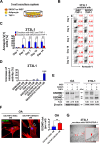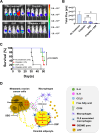Adipocyte pyroptosis occurs in omental tumor microenvironment and is associated with chemoresistance of ovarian cancer
- PMID: 38862973
- PMCID: PMC11167873
- DOI: 10.1186/s12929-024-01051-4
Adipocyte pyroptosis occurs in omental tumor microenvironment and is associated with chemoresistance of ovarian cancer
Abstract
Background: Ovarian carcinoma (OC) is a fatal malignancy, with most patients experiencing recurrence and resistance to chemotherapy. In contrast to hematogenous metastasizing tumors, ovarian cancer cells disseminate within the peritoneal cavity, especially the omentum. Previously, we reported omental crown-like structure (CLS) number is associated with poor prognosis of advanced-stage OC. CLS that have pathologic features of a dead or dying adipocyte was surrounded by several macrophages is well known a histologic hallmark for inflammatory adipose tissue. In this study, we attempted to clarify the interaction between metastatic ovarian cancer cells and omental CLS, and to formulate a therapeutic strategy for advanced-stage ovarian cancer.
Methods: A three-cell (including OC cells, adipocytes and macrophages) coculture model was established to mimic the omental tumor microenvironment (TME) of ovarian cancer. Caspase-1 activity, ATP and free fatty acids (FFA) levels were detected by commercial kits. An adipocyte organoid model was established to assess macrophages migration and infiltration. In vitro and in vivo experiments were performed for functional assays and therapeutic effect evaluations. Clinical OC tissue samples were collected for immunochemistry stain and statistics analysis.
Results: In three-cell coculture model, OC cells-derived IL-6 and IL-8 could induce the occurrence of pyroptosis in omental adipocytes. The pyroptotic adipocytes release ATP to increase macrophage infiltration, release FFA into TME, uptake by OC cells to increase chemoresistance. From OC tumor samples study, we demonstrated patients with high gasdermin D (GSDMD) expression in omental adipocytes is highly correlated with chemoresistance and poor outcome in advanced-stage OC. In animal model, by pyroptosis inhibitor, DSF, effectively retarded tumor growth and prolonged mice survival.
Conclusions: Omental adipocyte pyroptosis may contribute the chemoresistance in advanced stage OC. Omental adipocytes could release FFA and ATP through the GSDMD-mediate pyroptosis to induce chemoresistance and macrophages infiltration resulting the poor prognosis in advanced-stage OC. Inhibition of adipocyte pyroptosis may be a potential therapeutic modality in advanced-stage OC with omentum metastasis.
Keywords: Adipocyte pyroptosis; Chemoresistance; Inflammation; Omentum metastasis; Ovarian cancer.
© 2024. The Author(s).
Conflict of interest statement
The authors declare that they have no competing interests.
Figures






Similar articles
-
Extracellular vesicles from ovarian cancer cells induce senescent lipid-laden macrophages to facilitate omental metastasis.J Nanobiotechnology. 2025 Jul 26;23(1):540. doi: 10.1186/s12951-025-03612-7. J Nanobiotechnology. 2025. PMID: 40713812 Free PMC article.
-
Omental Macrophagic "Crown-like Structures" Are Associated with Poor Prognosis in Advanced-Stage Serous Ovarian Cancer.Curr Oncol. 2021 Oct 19;28(5):4234-4246. doi: 10.3390/curroncol28050359. Curr Oncol. 2021. PMID: 34677277 Free PMC article.
-
Adipocyte derived exosomes promote cell invasion and challenge paclitaxel efficacy in ovarian cancer.Cell Commun Signal. 2024 Sep 16;22(1):443. doi: 10.1186/s12964-024-01806-4. Cell Commun Signal. 2024. PMID: 39285292 Free PMC article.
-
Adipocyte Microenvironment in Ovarian Cancer: A Critical Contributor?Int J Mol Sci. 2023 Nov 22;24(23):16589. doi: 10.3390/ijms242316589. Int J Mol Sci. 2023. PMID: 38068912 Free PMC article. Review.
-
New Insights into Ferroptosis Initiating Therapies (FIT) by Targeting the Rewired Lipid Metabolism in Ovarian Cancer Peritoneal Metastases.Int J Mol Sci. 2022 Dec 3;23(23):15263. doi: 10.3390/ijms232315263. Int J Mol Sci. 2022. PMID: 36499591 Free PMC article. Review.
Cited by
-
Innovative optimization of greater omentum imaging report and data system for enhanced risk stratification of omental lesions.Cancer Imaging. 2025 Mar 10;25(1):28. doi: 10.1186/s40644-025-00848-2. Cancer Imaging. 2025. PMID: 40065469 Free PMC article.
-
The Role of Cancer Organoids in Ferroptosis, Pyroptosis, and Necroptosis: Functions and Clinical Implications.Biomolecules. 2025 May 2;15(5):659. doi: 10.3390/biom15050659. Biomolecules. 2025. PMID: 40427552 Free PMC article. Review.
-
Ovarian tumor microenvironment contributes to tumor progression and chemoresistance.Cancer Drug Resist. 2024 Dec 17;7:53. doi: 10.20517/cdr.2024.111. eCollection 2024. Cancer Drug Resist. 2024. PMID: 39802952 Free PMC article. Review.
-
TIGIT+ CD4+ regulatory T cells enhance PD-1 expression on CD8+ T cells and promote tumor growth in a murine ovarian cancer model.J Ovarian Res. 2024 Dec 20;17(1):252. doi: 10.1186/s13048-024-01578-y. J Ovarian Res. 2024. PMID: 39707532 Free PMC article.
References
MeSH terms
Grants and funding
LinkOut - more resources
Full Text Sources
Medical

